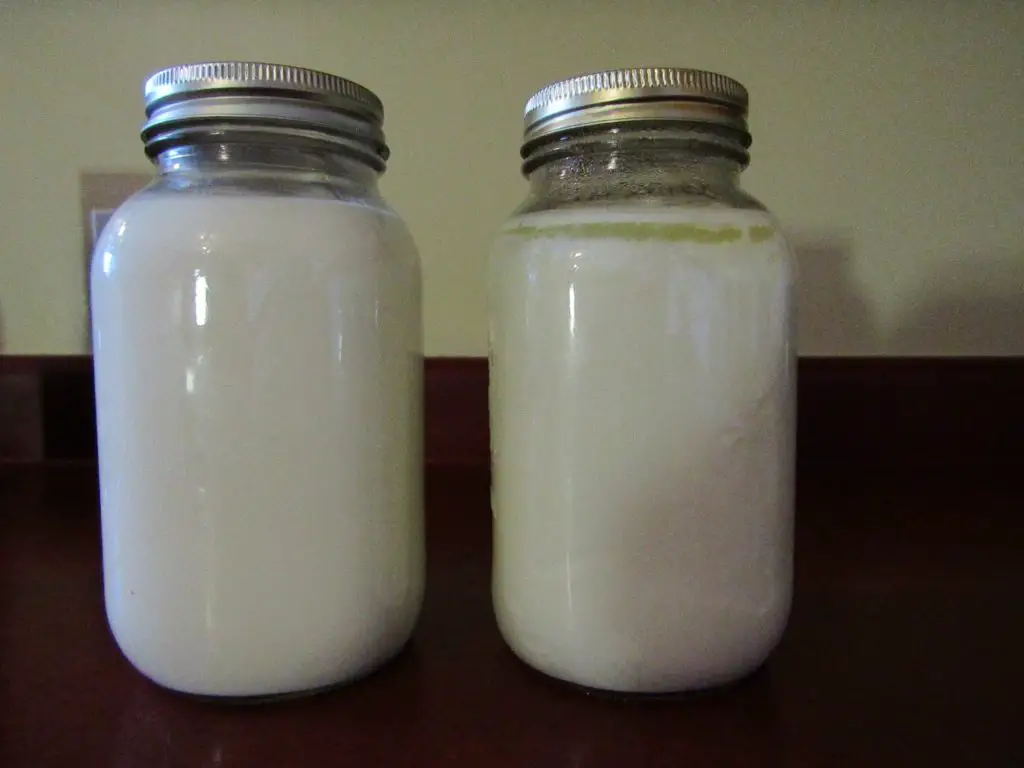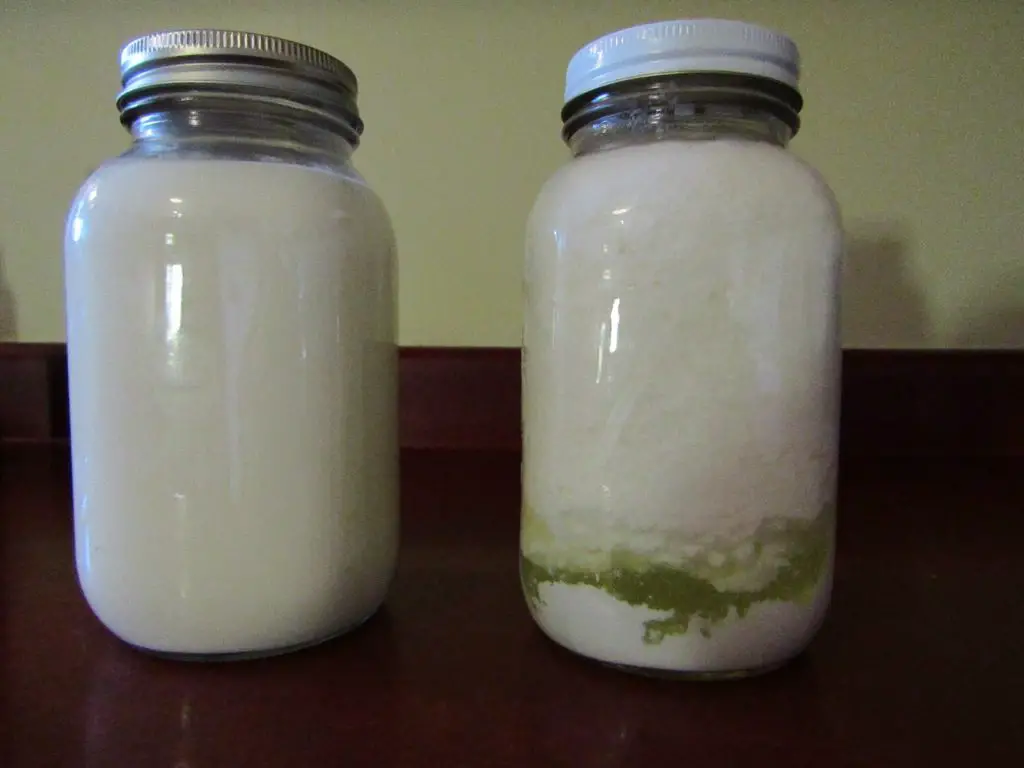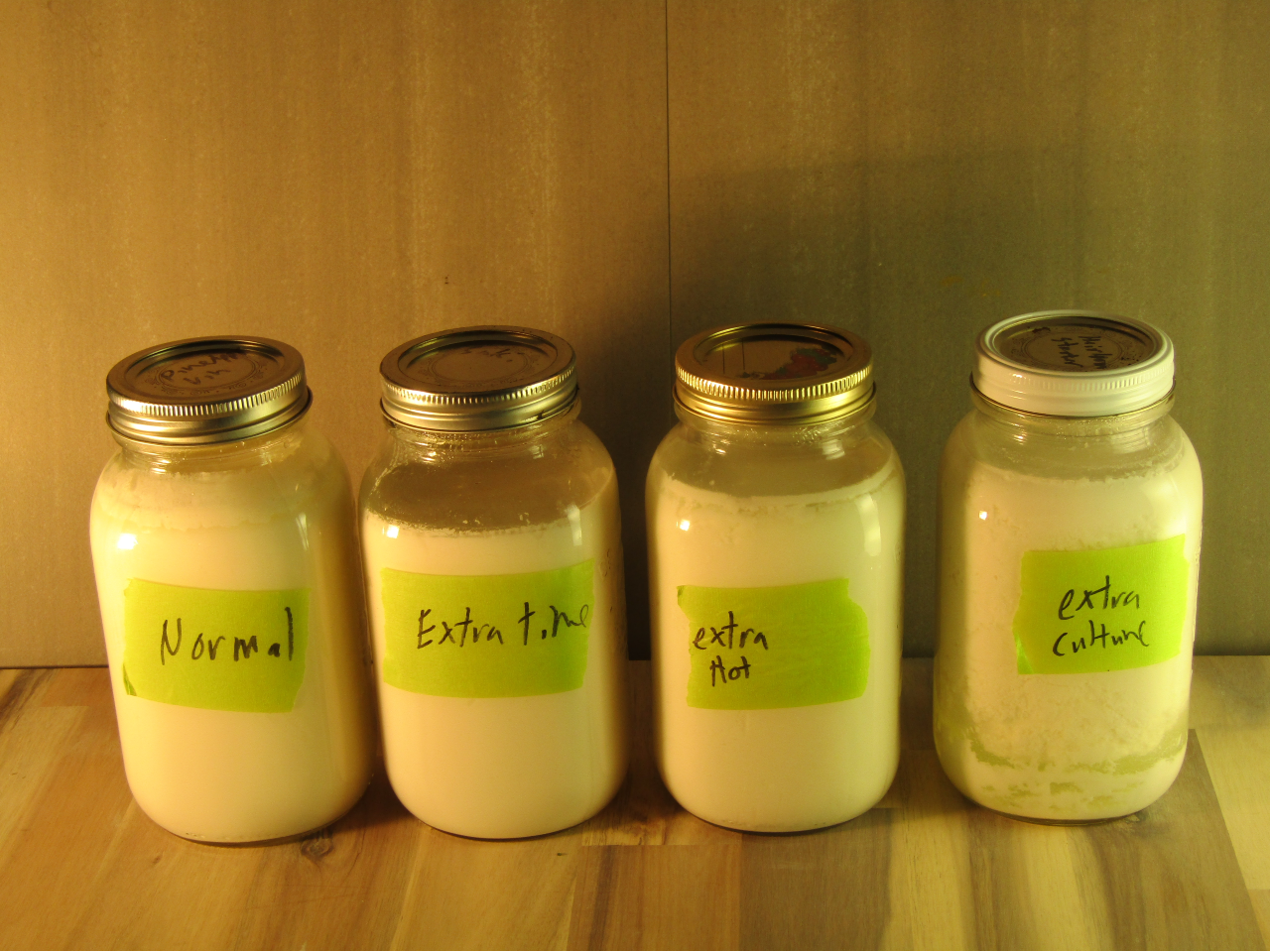This post contains affiliate links.
Opening a container of yogurt to find a layer of yellowish clear liquid sitting on the top of it is one of those things which begs to the question “Should I eat this or just throw it out?”, especially if you have made it yourself. The clear liquid which forms on the top of yogurt may be off putting to some but it is a normal part of yogurt.
The clear liquid on the top of yogurt is whey which is made up of water, liquid milk protein, lactose and lactic acid bacteria. It contains vitamin B1, B2, B5, B12, calcium, magnesium and other trace vitamins and minerals. It is also low in saturated fat and contains 2 grams of protein per cup.
If you are nervous about eating yogurt with whey on top, thinking that it has gone off or is somehow past its prime, set your mind at ease. The separation of whey from the solid protein in the yogurt is normal and not a sign of spoilage.
Why liquid separates from yogurt
As yogurt ferments the lactic acid bacteria acidifies the milk. Once the milk has reached a pH of 4.6 the proteins in the liquid part of the milk begin to thicken forming a gel like structure. As the pH drops the liquid part of the milk is forced out of the solid curds and because it is less dense it floats to the top of the container. The lower the pH the more whey which will be forced out of the solids of the milk.
Yogurt which has been fermented longer than 6-12 hours is prone to separation due to the lower pH as the lactic acid bacteria continue to acidify the milk. The lower the pH the greater chance it will separate. If you ferment your yogurt longer than 12 hours be careful not to disturb the yogurt while it is warm. Carefully place it in the fridge and let it cool before using it as any jaring or disturbance in the structure of the yogurt can cause it to separate.
Some commercial yogurt has additional thickeners and gelling agents mixed in with the yogurt to make it thicker and survive transportation and handling without losing its texture and structure. These additives do a great job of holding the solids in the yogurt in a semi-solid form but the liquid components of the yogurt will separate and float to the top, even if the pH is still in the higher range.
To learn more about the many ways you can make yogurt with full step-by-step instructions and full explanations follow this affiliate link for one of the best books on the topic called “Homemade Yogurt and Kefir“.
How to prevent yogurt from separating
The main reason your yogurt has separated is its pH has dropped lower than 4.6 when this happens the solids in the milk disassociate with the liquid whey. This causes the whey to rise to the top of the container.
The low pH can be caused by a longer fermentation time, fermenting at too high a temperature or using too much starter. Each of these will help the lactic acid bacteria in the culture to acidify the milk to a higher degree.
How Temperature affects Whey Separation in Yogurt

There are two types of yogurt cultures on the market:
Thermophilic – Requiring temperatures above room temperature
Mesophilic – Is active at room temperature
Each has an optimal temperature range in which the yogurt culture is most active but both types are made up of several species of lactic acid bacteria. Each of these species have a different temperature range which they can reproduce.
The majority of the species found in these cultures grow faster in warmer temperatures so if you ferment your yogurt at too high a temperature you encourage the growth of the lactic acid bacteria which in turn produce more lactic acid.
Higher temperatures also affect the chemical properties of the milk itself making the casein proteins more attractive to each other. This helps the yogurt to gel faster but also will hasen the whey separation from the milk solids. To prevent this from happening lower the temperature to the lower range fermentation range recommended by the culture you are using. This will slow the growth of the lactic acid bacteria and produce a more stable yogurt.
Alternatively you could ferment your yogurt for a shorter period of time (in fact this is one of the methods talked about in “Four Easy Ways to Shorten Yogurt Incubation Time (Fast Yogurt )“
How Long Fermentation Time Affects Whey Separation in Yogurt
A long fermentation time gives the yogurt culture a longer period to acidify the milk. At the beginning of a fermentation period there are few lactic acid bacteria in the milk but because the milk is full of fermentable sugar the lactic acid bacteria multiply quickly.
Once they have reduced the milks pH to 4.6 or so the milk will start to coagulate forming a gel like structure. Once this happens the proteins in the milk will continue to form connections with other milk proteins and slowly disassociate with the liquid in the milk. As this happens the whey will rise to the top of the container.
You can prevent this from happening by shortening the fermentation time. Watch the milk carefully and once it starts to gel remove it from the incubator and refrigerate it. Keep a log to track the fermentation time and temperature to help you make decisions for future batches.
How Extra Yogurt Culture Affects Whey Separation in Yogurt

As mentioned above the number of active lactic acid bacteria in a culture determines how fast the yogurt will acidify. Heat will increase the rate of growth, time will give the lactic acid a chance to multiply but if you start with a higher amount of active lactic acid bacteria then you are short circuiting the growth period.
With a high number of lactic acid bacteria in a milk sample the bacteria will quickly consume the fermentable sugars and acidify the milk faster. Additionally if you are using a previous batch of yogurt it will already have a lower pH which will instantly lower the pH of the milk it was added to.
Only use the recommended amount of starter found on the package or two tablespoons of cultured yogurt as a starter.
Alternate ways to prevent yogurt separation
Use a higher fat content milk
The higher fat content requires that there is less water in the milk leading to less separation. High fat milk makes a creamier yogurt which does not have the same structure as normal yogurt. It is softer and smoother than low fat milk which is good for making rich toppings or desserts.
Add thickeners to the milk prior to fermentation
There are several types of thickeners you can use which you can read about in this post but basically the idea is that the liquid in the milk will be included in the matrix with the addition of a thickener which prevents its separation.
What to do about the whey separating from yogurt
Small amounts of whey separating from your yogurt is normal and expected. It forms on the top of the container or in divots left when you scoop some of the yogurt out. For larger amounts of whey you have two options.
Stir the whey back into your yogurt
Whey is full of beneficial vitamins and minerals as well as live probiotics which help your digestive system maintain an even keel. Per cup it will provide 20% of the RDI of B2, 7% B12 and contains 25% of the recommended calcium in a natural form with 6% the magnesium. nutrition facts
By stirring in the whey back into your yogurt you are improving the nutritional value of the yogurt but also retaining the texture. Although the whey will separate again if you leave it alone for a while, stirring the whey back into the yogurt will work fine if you consume it immediately after.
The yogurt may be tangier than normal but that is just an effect of the lower pH and not a sign of spoilage. If it is too tangy for you add some honey, use it on top of fruit or make it into a smoothie or shake.
Pour the whey off the top of your yogurt
If you choose to pour the whey off the top the remaining yogurt will be thicker and creamier. It will have a higher fat content and fewer simple sugars which are removed with the whey. This makes for a great yogurt for topping fruit, cereal or making into thick dips.
Greek yogurt is made by removing some of the whey intentionally before packaging to make a thicker product. The yogurt is placed in a filter where the liquid whey drains off and the solids which are made up of solid proteins and fat remain behind.
How to remove whey from yogurt
If you like a thicker yogurt then you can intentionally remove some of the whey from your homemade yogurt by hanging it for 8-24 hours. The solids will remain behind as the liquid whey drains away into a container.
Instructions:
- Place a clean cotton cloth over a bowl
- Pour the yogurt into the center of the cloth
- Gather the edges of the cloth and tie a string around them to form a bag
- Hang the bag over the bowl for 8-24 yours depending on how thick you want your yogurt
- Remove the yogurt from the bag and place into the fridge
- Pore the whey into a container and place it in the fridge
Use whey for baking
Whey is a weak acid which reacts quickly with the baking soda or baking powder used in quick breads. This creates more CO2 as the basic ingredients react with the acidic ingredients in the recipe. This makes for more bubbles and causes the batter to rise more, making a lighter fluffier product.
Whey can be used to make biscuits, muffins, pancakes and waffles. Any type of quickbread baking where the raising agent is some type of soda as it is the basic soda which reacts with the acidic whey to give the extra rising power.
Add whey to smoothies
There are two ways you can use whey in smoothies.
- Make the whey into ice cubes and use with fresh fruit smoothies
Simply pour the whey into ice cube trays and freeze. When you want to make a smoothie place two or three cubes into the blender along with the fresh fruit and blend until smooth
- Use refrigerated whey with frozen fruit
Replace the liquid in your normal smoothie recipe with whey. Add the frozen fruit and blend until it is smooth.
Add whey to soups or stews
Whey adds a tangy flavor to soups and stews due to its lower pH. It is great for replacing some of the liquid in soups, adding complexity to any soup recipe.
The acidity will help tenderize the meat in stews, producing a rich thick stew without having to add thickeners to the base.
Drink whey
Whey can be drunk plain or added to fruit or vegetable juice. The tangy flavor is a pleasant addition to freshly juiced vegetable juice like carrot-ginger or celery and apple.


